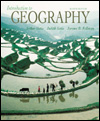 |  Introduction to Geography, 8/e Arthur Getis,
San Diego State University
Judith Getis
Jerome D. Fellmann,
University of Illinois, Urbana-Champaign
Political Geography
ProblemsWeb Page Questions: Answer the following questions using the web pages listed.
1. United Nations - http://www.un.org
Answer the following questions about the United Nations in the spaces provided.- How many permanent member countries does the United Nations have?
- Is Japan an original member of the UN?
- Is Iraq an original member of the UN?
- Is Tonga a current member of the UN?
- Is Switzerland a current member of the UN?
- Do member nations pay annual dues?
- Does the UN engage in peacekeeping activities?
- Does the UN concern itself with environmental issues?
2. The World Factbook 2000 - http://www.odci.gov/cia/publications/factbook/index.html
For each of the following countries, list its type of government and the number of
international organizations to which the country belongs.| Country | Type of Government | Number of International Organizations | | Afghanistan | | | | Argentina | | | | Denmark | | | | Egypt | | | | New Zealand | | | | Philippines | | | | Qatar | | | | South Africa | | |
Problems: 1. Geographers have traditionally distinguished between natural (physical)
and artificial boundaries. On the following outline map of the United
States, distinguish between these two types of boundaries by drawing in with
a heavy or colored pen those state boundaries (or portions thereof) which are
based on physical features. Include any portions of international boundaries
as well. Answer the following questions based on what you draw on the map. - In which part of the U.S. is the majority of state boundaries based upon
natural features?
__________________________________________________________ - In which part of the country is the majority of state boundaries based
on artificial lines?
_______________________________________________________________________ - Explain the difference.
_________________________________________________________________________________
 <a onClick="window.open('/olcweb/cgi/pluginpop.cgi?it=jpg::U.S.A.::/sites/dl/free/0072367229/9469/image09_01.jpg','popWin', 'width=326,height=224,resizable,scrollbars');" href="#"><img valign="absmiddle" height="16" width="16" border="0" src="/olcweb/styles/shared/linkicons/image.gif">U.S.A. (10.0K)</a>U.S.A. <a onClick="window.open('/olcweb/cgi/pluginpop.cgi?it=jpg::U.S.A.::/sites/dl/free/0072367229/9469/image09_01.jpg','popWin', 'width=326,height=224,resizable,scrollbars');" href="#"><img valign="absmiddle" height="16" width="16" border="0" src="/olcweb/styles/shared/linkicons/image.gif">U.S.A. (10.0K)</a>U.S.A.2. Many of the concepts discussed in this chapter can be demonstrated using
examples found on the European continent. The following outline map contains
the letters A through L. Each location represents an aspect of
political geography. In the space provided, indicate which letter is represented
by that phenomenon. - Compact state _____
- Elongated state _____
- Enclave _____
- Ethnographic boundary _____
- Exclave _____
- Fragmented state _____
- Mini-state _____
- Nation-state _____
- National core _____
- Nationalist party _____
- Perforated state _____
- Relocated capital _____
 <a onClick="window.open('/olcweb/cgi/pluginpop.cgi?it=jpg::Europe::/sites/dl/free/0072367229/9469/image09_02.jpg','popWin', 'width=534,height=491,resizable,scrollbars');" href="#"><img valign="absmiddle" height="16" width="16" border="0" src="/olcweb/styles/shared/linkicons/image.gif">Europe (730.0K)</a>Europe <a onClick="window.open('/olcweb/cgi/pluginpop.cgi?it=jpg::Europe::/sites/dl/free/0072367229/9469/image09_02.jpg','popWin', 'width=534,height=491,resizable,scrollbars');" href="#"><img valign="absmiddle" height="16" width="16" border="0" src="/olcweb/styles/shared/linkicons/image.gif">Europe (730.0K)</a>EuropeCritical Thinking Questions: - Maps and map projections have long been used to influence public opinion.
Why do you think the former Soviet Union portrayed itself in a polar projection?
Prior to the entry of the United States into World War II, American isolationists
used Eurasia-centered maps to dismiss the threat from Germany and Japan. Explain
the reasoning behind it and comment on its fallacy.
- Figure 9.3 in the textbook shows claims made by various nations to Antarctica.
Review the Movements of the Continents discussion in Chapter 3 and
consult an atlas for the location of know mineral deposits in the Southern
Hemisphere. Discuss why these claims may not be as ludicrous as they may seem
at first glance.
- The growth and diffusion of various religions during the 20th
century has affected national unity and created situations for hostilities
between groups, including actions by separatists. Name two examples each from
Europe, Asia and Africa to support this observation. Discuss the problem and
comment on the solution, if any.
- Study the location the capital of your state or province and that of two
other states or provinces. If possible, one of the other capitals should be
an ;quot;original;quot; and the other more recently established. Discuss,
compare and contrast these capital cities as core areas or as being spatially
convenient to its jurisdiction's population.
- Thee European Union is modeled roughly after the United States of America,
a federation of sovereign states joined together for the common good such
as economic stability, defense and shared resources. Predict the future of
the EU. As it matures, will there be a seamless national entity equivalent
to the USA? Explain your reasoning.
|
|



 2002 McGraw-Hill Higher Education
2002 McGraw-Hill Higher Education

 2002 McGraw-Hill Higher Education
2002 McGraw-Hill Higher Education